WE BUILD A KTM 366SXF: CHEAPEST HORSEPOWER EVER!
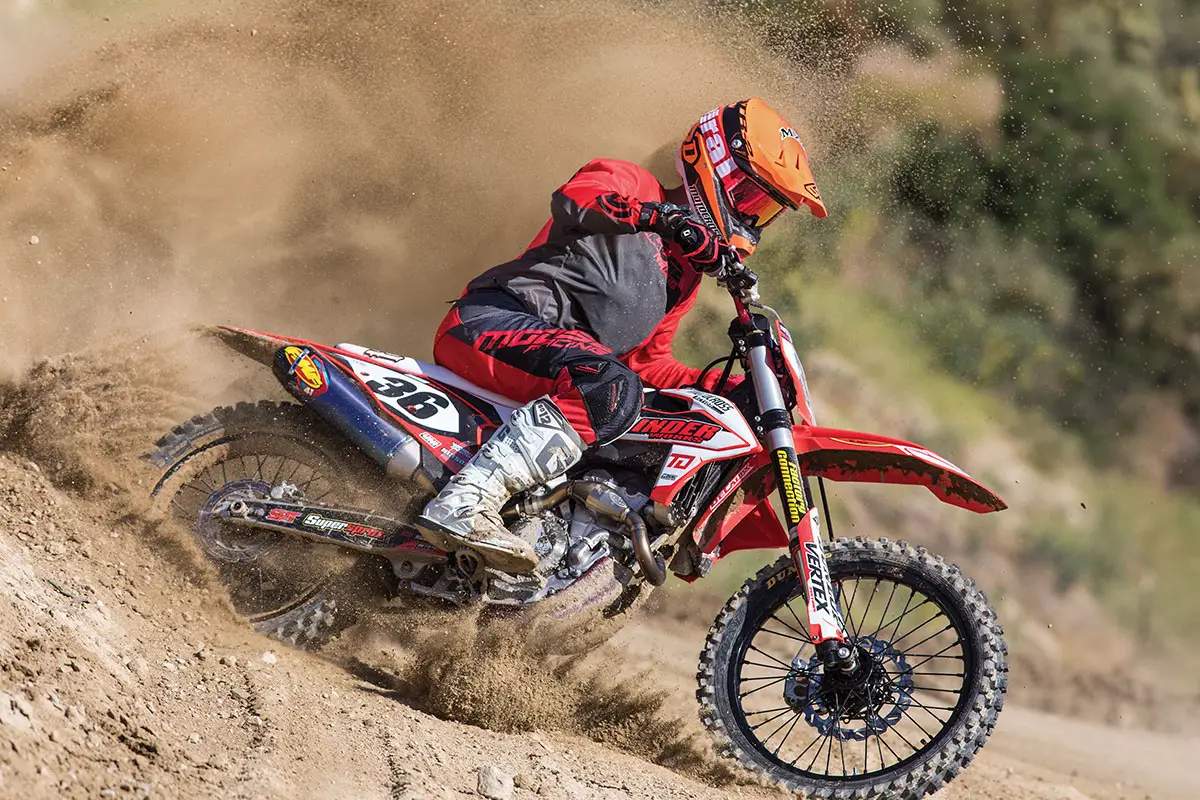
WE BUILD A KTM 366SXF: CHEAPEST HORSEPOWER EVER!
The MXA wrecking crew believes that the stock 350 does a good job of bridging the gap between the 250 and 450, but we have always stated a preference for midsize bikes that have the personality of a 450, not of a 250. That is where MXA’s KTM 366SXF comes in.
Back when the KTM 350SXF was first announced for the 2011 model year, we were hoping for a mid-size 450, not an upsized 250—something along the lines of the 2010 KTM 400XCF or the original Yamaha YZ400. We envisioned a bike that was lighter and more agile than a 450 but with a broad, easy-to-use, torquey, mid-sized powerband, not a big-bore 250 that had to be revved to 13,400 rpm to get max power.
WE EXPECTED HUSQVARNA EXECS TO CARRY US FROM THE BOARDROOM ON THEIR SHOULDERS. THAT DIDN’T HAPPEN.
Our feelings were magnified when KTM bought Husqvarna and, in 2015, began importing the Husqvarna FC350 to the USA. At that time, we switched our talks about the future of the 350 over to the Husqvarna R&D department, thinking they were most in need of a unique bike to separate themselves from KTM. Here is a verbatim transcript of what we said to the Husqvarna execs: “We would much prefer that Husqvarna did not produce a clone 350 that is only differentiated from the KTM by white plastic and a carbon matrix subframe. Plus, the motorcycle world would benefit from a different option from one that is already offered from the parent brand in a different color scheme. Eventually, Husqvarna needs to develop its own products, not just copy what KTM builds.
“Most MXA test riders think that a mid-sized Open bike would suit a wider range of riders than a hopped-up-on-Adderall over-sized 250. Husqvarna could have a machine of its own by taking its current clone FC350 and pumping the displacement up to 365cc or 380cc to offer more power in the midrange and a torquier feel down low. Husqvarna could give the rider the option of riding harder in the meat of the powerband instead of waiting for the powerband to hit peak horsepower at the same time it hits the rev limiter. The larger-displacement engine’s power would be increased by at least 5 horsepower in the mid and reach its peak several thousand rpm lower in the curve. Displacement would determine power output, not rpm.
“Since there is no actual 350cc class, there is no reason to adhere to the pipe dream that Youthstream’s Giuseppe Luongo and the AMA’s Steve Whitelock had about banning the 450 class and replacing it with a 350 class over a decade ago. That dream was dead on arrival, so why stick to its formula?
A MID-SIZED DISPLACEMENT HUSQVARNA—LET’S CALL IT A FC400, WOULD BE A SMASH HIT.
“We suggest that a true mid-size Open bike in the Husqvarna stable would no longer be the country-bumpkin cousin of the KTM 350SXF. It would give Husqvarna a stand-alone bike that would set it apart from its Austrian benefactor. As it is now, the KTM 350SXF, Husky FC350 and GasGas MC 350F are the only 350cc bikes on the showroom floors, and they can only succeed by stealing sales from each other.
“Additionally, a mid-sized displacement Husqvarna—let’s call it a FC400, would be a smash hit in the enduro, cross-country and GNCC milieu.”
Obviously, we expected the Husqvarna execs to stand up and cheer, give us three hurrahs and carry us from the boardroom on their shoulders. That didn’t happen. Instead, they stifled a yawn and, in a roundabout way, thanked us for wasting their time. We understand that for the two Austrian brands, the 350cc formula has been a big success. The 350SXF and FC350 have been embraced by Vet racers, play riders, trail riders and cross-country racers. Even the MXA wrecking crew believes that the 350 does a good job of bridging the gap between the 250 and 450. It allows riders who would like a stronger 250 or a mellower 450 a place to hang their hats. And, best of all for Husqvarna, the development of the FC350 incurs no R&D costs. The FC350 is a byproduct of the Easy-Bake-Oven approach to manufacturing called “platform sharing.”
A MID-SIZED DISPLACEMENT HUSQVARNA—LET’S CALL IT A FC400, WOULD BE A SMASH HIT.
But, try as we could to assure Husqvarna that a 370cc version of the FC350 would require nothing more in the way of parts than a new cylinder and bigger piston; they countered that those parts weren’t in the Mattighofen warehouse. After six years of cajoling Husky to take our advice, it was obvious that we had two choices: shut up or do it ourselves. We chose the latter.
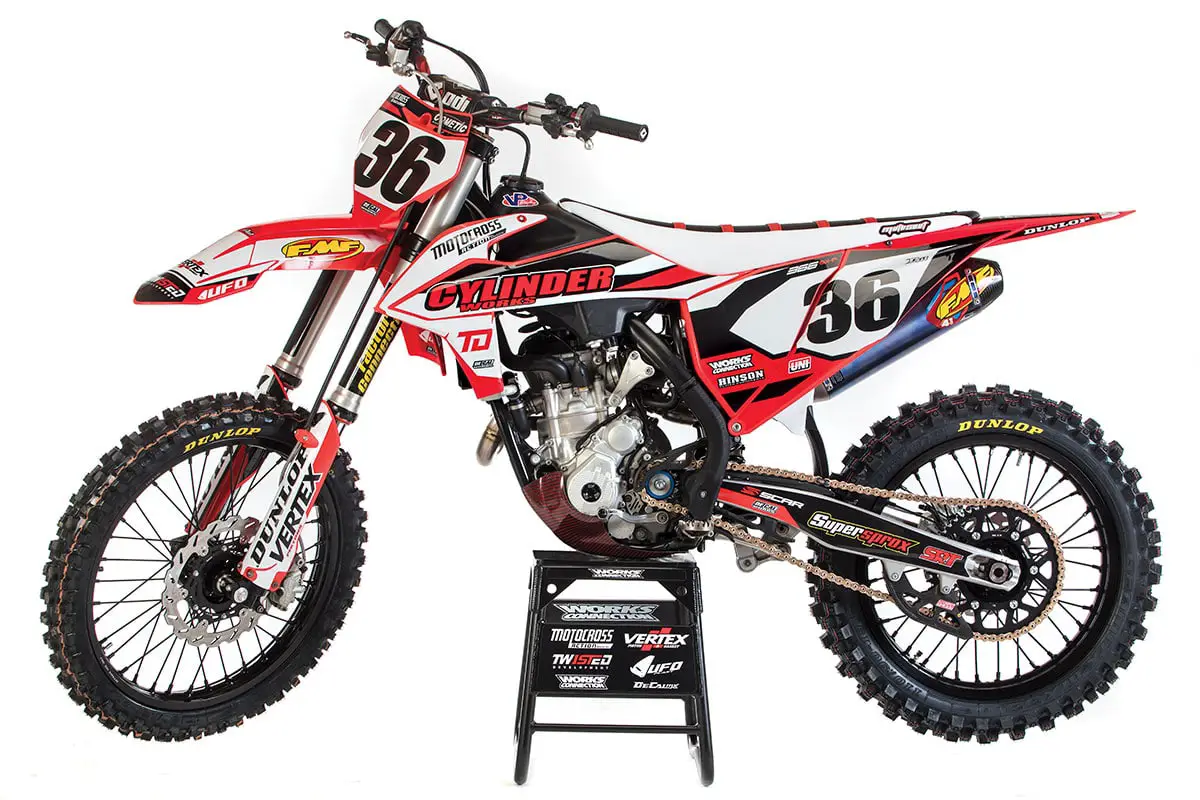
The MXA wrecking had a simple plan. If we couldn’t get Husqvarna to make a torquey, broad and usable midsize Open bike, we would build our own. It’s not like we were the Lone Ranger in our pursuit of a more midrange-worthy KTM or Husqvarna 350. We had tested a wide variety of big-bore KTM 350SXFs over the years, some as large as 400cc, but we didn’t feel the need to go displacement crazy. We weren’t looking for grunt; instead, we wanted more power in the right places, which is where the Cylinder Works KTM/Husqvarna 366cc kit comes into the picture.
First and foremost, it is important to note that this is a test of the Cylinder Works 366 engine kit—and that is what you should find most appealing about this MXA project bike. Yes, we did go all out on the rest of the bike, but that is not necessary for you to do to reap the rewards of MXA’s project. The bling is just icing on the cake. Given that the majority of consumers interested in buying the Cylinder Works 366cc engine kit already own an FC350 or 350SXF and have set it up to their personal tastes, MXA’s suspension, engine work, mapping, exhaust, plastic, graphics and accoutrement choices are only offered as suggestions—suggestions that come with a hefty price tag.
THIS BIG-BORE KIT IS THE CHEAPEST HORSEPOWER YOU WILL EVER BUY FOR YOUR 350.
But, the actual engine kit that takes your FC350 or 350SXF from 349.7cc to 366cc only costs $649.95. For that money, you get a brand-new cast cylinder that accepts a 2mm-larger Vertex piston kit and a complete set of Cometic gaskets. It is a bolt-on kit that ups the bore and stroke from 88mm by 57.5mm to 90mm by 57.5mm. All you have to do is remove the stock parts, slip the new cylinder and piston on, and drop the head back into place. By four-stroke standards, this is the simplest big-bore mod known to man.
 Factory Connection’s Kayaba conversion kit turns the WP Xact air forks into Kayaba SSS coil-spring forks.
Factory Connection’s Kayaba conversion kit turns the WP Xact air forks into Kayaba SSS coil-spring forks.
Let’s cut to the chase—in six parts.
(1) The biggest change. The 366 powerband had nothing in common with the stock KTM 350SXF or Husqvarna FC350 mills. Every test rider came back from his initial test ride and said, “This feels like a completely different motorcycle. It shares very little with the stock 350 engine.” That was music to our ears. We didn’t want to make a 350 with more power; we wanted a completely different style of power, and that is what we got.
(2) The powerband. MXA’s 366SXF felt considerably beefier off the bottom. The added bonus of more displacement, even just 16.3cc more, resulted in power in places where the stock 350 engine was at its weakest. The 366SXF hit with a rush of power. It felt very hooked up, was blessed with more torque and could pull the next tallest gear any time you felt like shifting. It still revved on top, but that was no longer a necessary destination. Instead, test riders would let it rev to where they felt comfortable and then short shift to the next gear. The powerband was awesome. Instead of a powerband that was skewed to top-end rev, the 366 kit turned the 350SXF into a midrange engine.
(3) Horsepower. The 366SXF made more horsepower than the stock 350SXF, but, most significant, the 366 kit brought peak horsepower down from 12,400 rpm on the 350SXF to 10,000 rpm on the 366. The biggest horsepower gains from the 366 kit were from 6000 rpm to 10 grand. We expected the 366 kit to suffer in top-end power because that is what happens when an engine has to push a bigger piston at faster and faster revolutions. No test riders took the power numbers over 10,000 rpm seriously, because even though the 366 was willing to rev to 13,400 rpm, it got its work done lower in the powerband and with more gusto than the 350.
(4) From the saddle. With all the power in the perfect pocket, test riders could generate more horsepower without having to go flat out to get the most out of the engine. We could short shift. We could rev it. We could stay at a lower rpm, and we could get out of corners with a more manageable power delivery than on a 450 and less clutch than on a 350.
(5) Price for power. This big-bore kit is the cheapest horsepower you will ever buy for your KTM or Husqvarna 350 (motocross or enduro model). For the cost of Cylinder Works’ KTM 366SXF engine kit, you could only buy one half of a premium exhaust system, 16 gas tanks full of VP MRX02, or a set of titanium intake and exhaust valves. None of those mods will make as much horsepower as the $650 Cylinder Works kit.
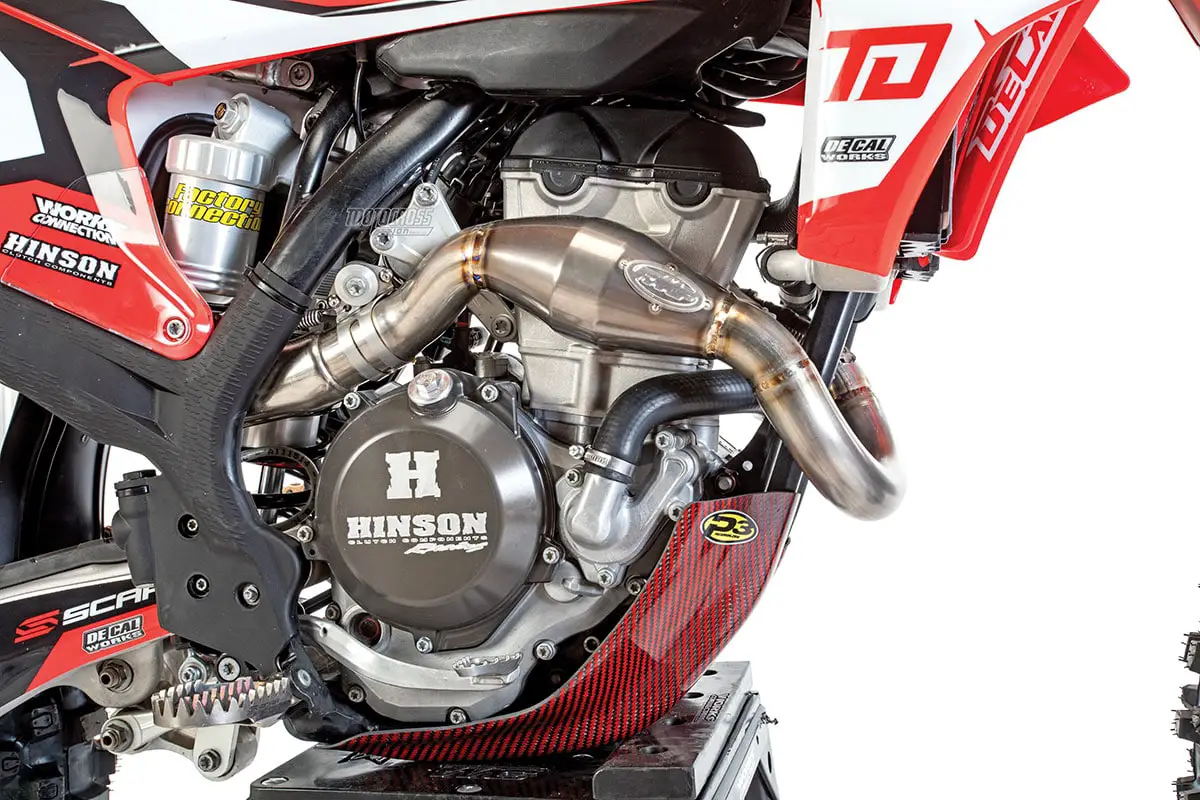 The 366SXF delivers more low-end, increased torque and the ability to pull the next tallest gear.
The 366SXF delivers more low-end, increased torque and the ability to pull the next tallest gear.
During our KTM 366SXF test, we did succumb to the lure of increased performance, not because we were unhappy with the way it ran with just the cylinder kit, but because we wanted to see the kit’s hop-up potential. We had Twisted Development work on the cylinder head and add a tunable Vortex ignition while FMF added its exhaust system. The results were the same expected gains that they would have gotten on the stock 350SXF engine.
MOST SAID THAT THEY WERE NEVER TRULY COMFORTABLE HAVING TO HOLD THE 350 ENGINE WIDE OPEN DOWN EVERY STRAIGHT.
(6) Test riders’ thoughts. For this test, MXA used test riders who raced 350s as their personal bikes. It was no problem finding volunteers, because we had Vet, Intermediate and Pro test riders whose go-to bikes were 350s. In the beginning, they struggled with the 366 engine because they wanted to rev the engine to the moon. Even with their high-rpm mindset, they recognized the advantage of the stronger low and broader midrange. In time, they realized that revving the engine was giving horsepower away that they had gained in the midrange. Once they realized the error of their ways and got more adept at shifting at peak and short shifting to the next tallest gear to let the engine pull, their lap times fell with each lap.
A distinct pattern began to form. The slower the test rider the quicker he adapted to the new powerband. Most said that they were never truly comfortable having to hold the 350 engine wide open down every straight. They loved that the 366 got up to speed quicker and didn’t require a suicide approach to fast straights; however, the faster the test rider, the more conflicted he was about trading rpm for torque. But, after the back-to-back testing between the KTM 366SXF and the stock KTM 350SXF, they all preferred the 366 powerband.
Best of all, it fulfilled the promise of a mid-sized Open bike.
 The 366cc big-bore kit is the cheapest horsepower you will ever buy for your KTM or Husqvarna 350 (motocross or enduro model), especially if you are on the verge of rebuilding your well-used 350SXF top-end—in which case you get a 366cc engine for a few dollars more.
The 366cc big-bore kit is the cheapest horsepower you will ever buy for your KTM or Husqvarna 350 (motocross or enduro model), especially if you are on the verge of rebuilding your well-used 350SXF top-end—in which case you get a 366cc engine for a few dollars more.
WHAT ELSE DID WE DO TO OUR KTM 366SXF?
The MXA wrecking crew never leaves well enough alone. It’s not in our DNA. We are driven to explore all possible options. That is the nature of a project bike. By no means do we expect every racer interested in the Cylinder Works 366SXF kit to go whole hog. We did because we wanted to show what was possible.
CYLINDER WORKS 366 KIT: The cylinder, piston, rings and gaskets were part of the 366 kit.
www.cylinder-works.com
ANTIGRAVITY BATTERIES: Lightweight lithium-ion battery. www.antigravitybatteries.com”
DECAL WORKS: Decal Works supplied the semi-custom graphics kit, pre-printed number plate backgrounds and clear plastic graphics guards. www.decalmx.com
FACTORY CONNECTION KAYABA/WP FORKS: Factory Connection added a Kayaba coil-spring conversion WP kit and fork lugs, which are required for the Technical Touch Racing Kayaba kit. www.factoryconnection.com
DIRT TRICKS: We ran a Dirt Tricks spring-loaded cam chain tensioner. www.dirttricks.com
DUNLOP TIRE: Dunlop MX33 tries were used front and rear. www.dunlopmotorcycletires.com
FMF RACING: The exhaust system was a full Ti MegaBomb RCT 4.1 and muffler. www.fmfracing.com
HINSON CLUTCH COMPONENTS: We ran the stock KTM steel clutch basket with Hinson clutch plates and clutch cover. www.hinsonracing.com
MALCOLM SMITH MOTORSPORTS: Malcolm Smith provided our test bike and any necessary OEM KTM parts. www.malcolmsmith.com
MOTO SEAT: The custom cool seat cover was built by Moto Seat. www.motoseat.com
NIHILO CONCEPTS: Clutch and brake lever covers. www.nihiloconcepts.com
ODI GRIPS & HANDLEBARS: ODI supplied the V2 Lock-On grips and handlebars. www.odigrips.com
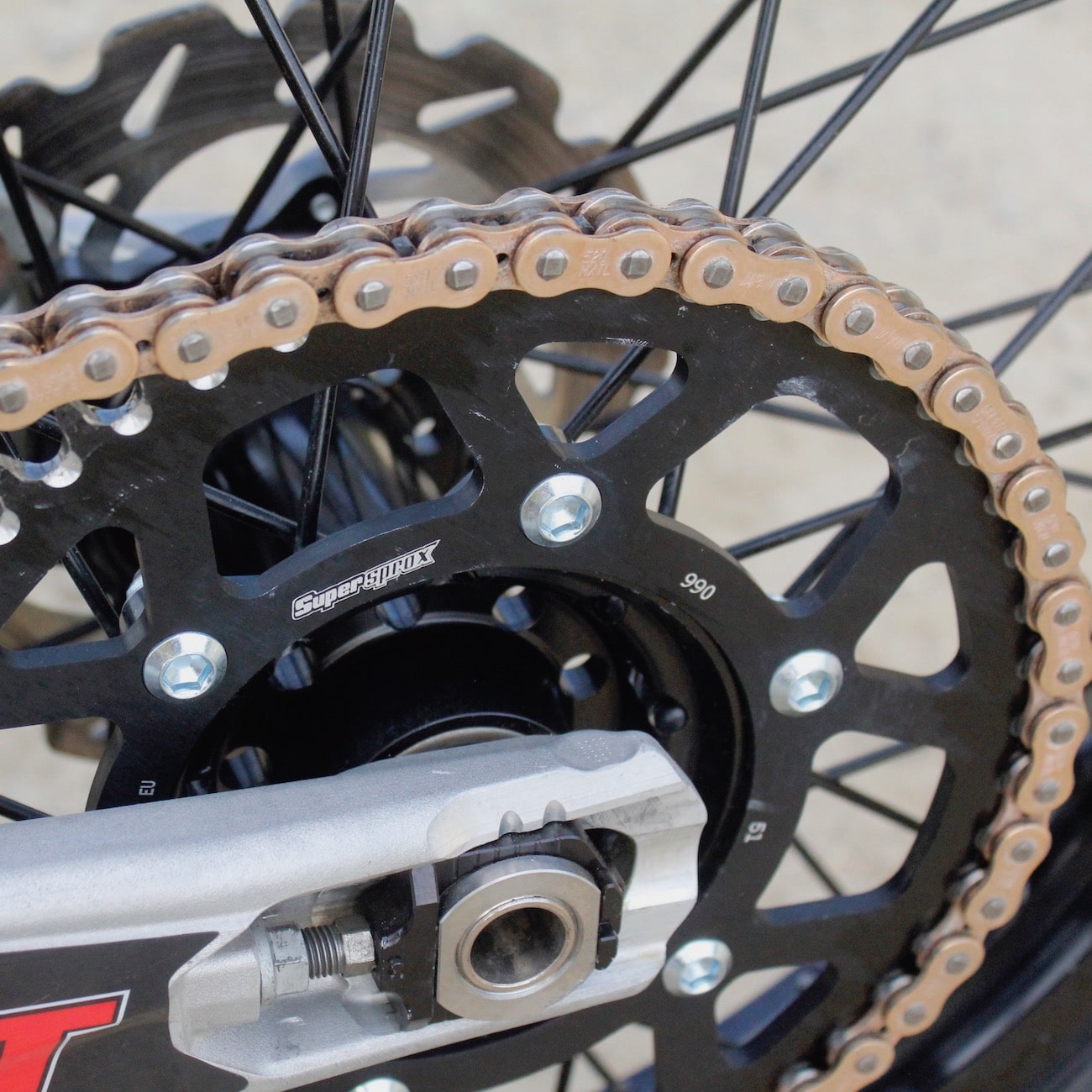
SUPERSPROX: We changed the gearing during testing with SuperSprox sprockets and a Gold MX Race Chain (G520-MXT-L-120). www.supersproxusa.com
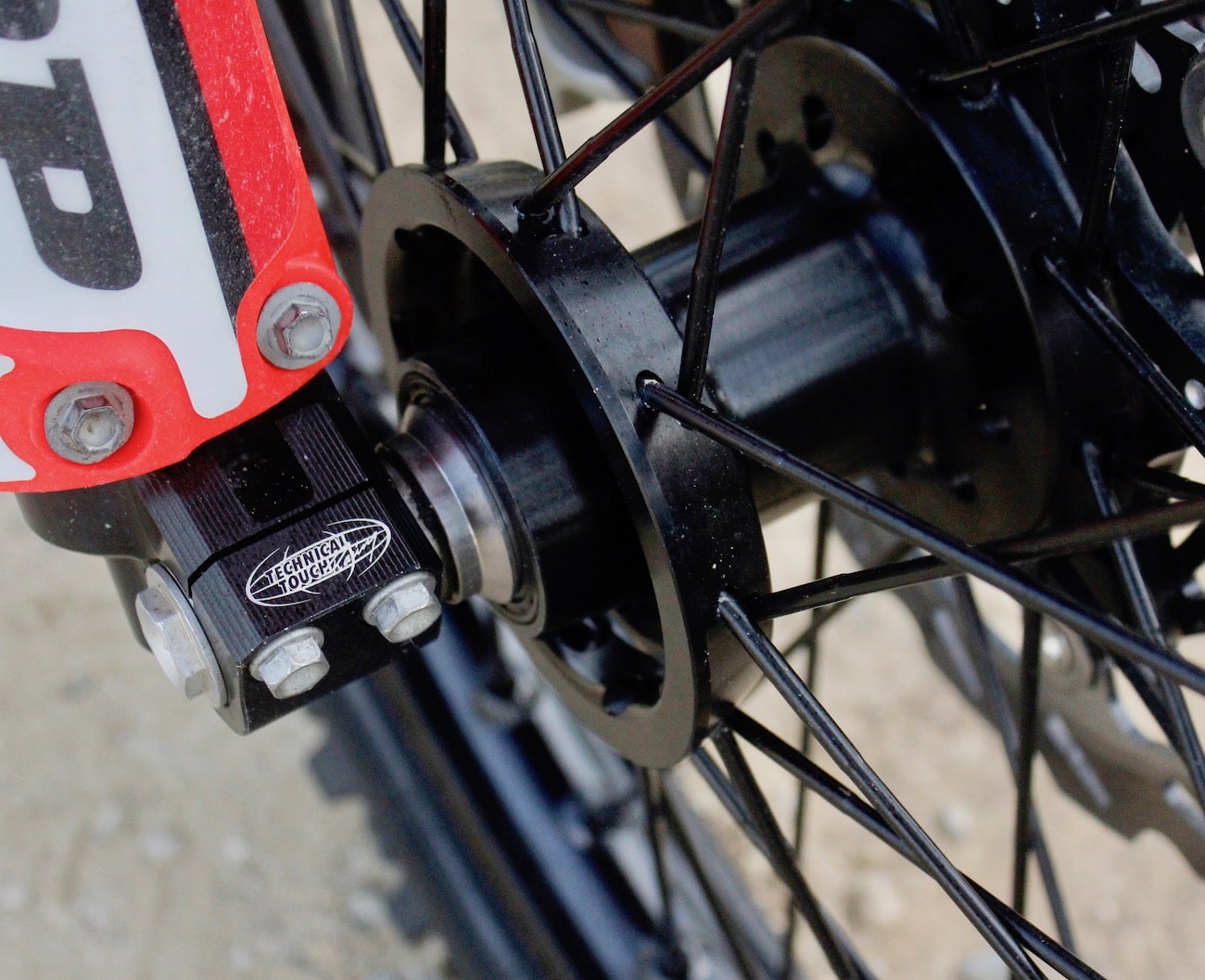
SRT OFFROAD WHEELS: The black-on-black hubs and rims came from SRT.www.srtoffroad.com
P3 CARBON: The P3 Carbon X-Series skid plate only weighs 3/4 of a pound. www.p3carbon.com
SCAR: The titanium footpegs were from Scar. www.scar-racingusa.com
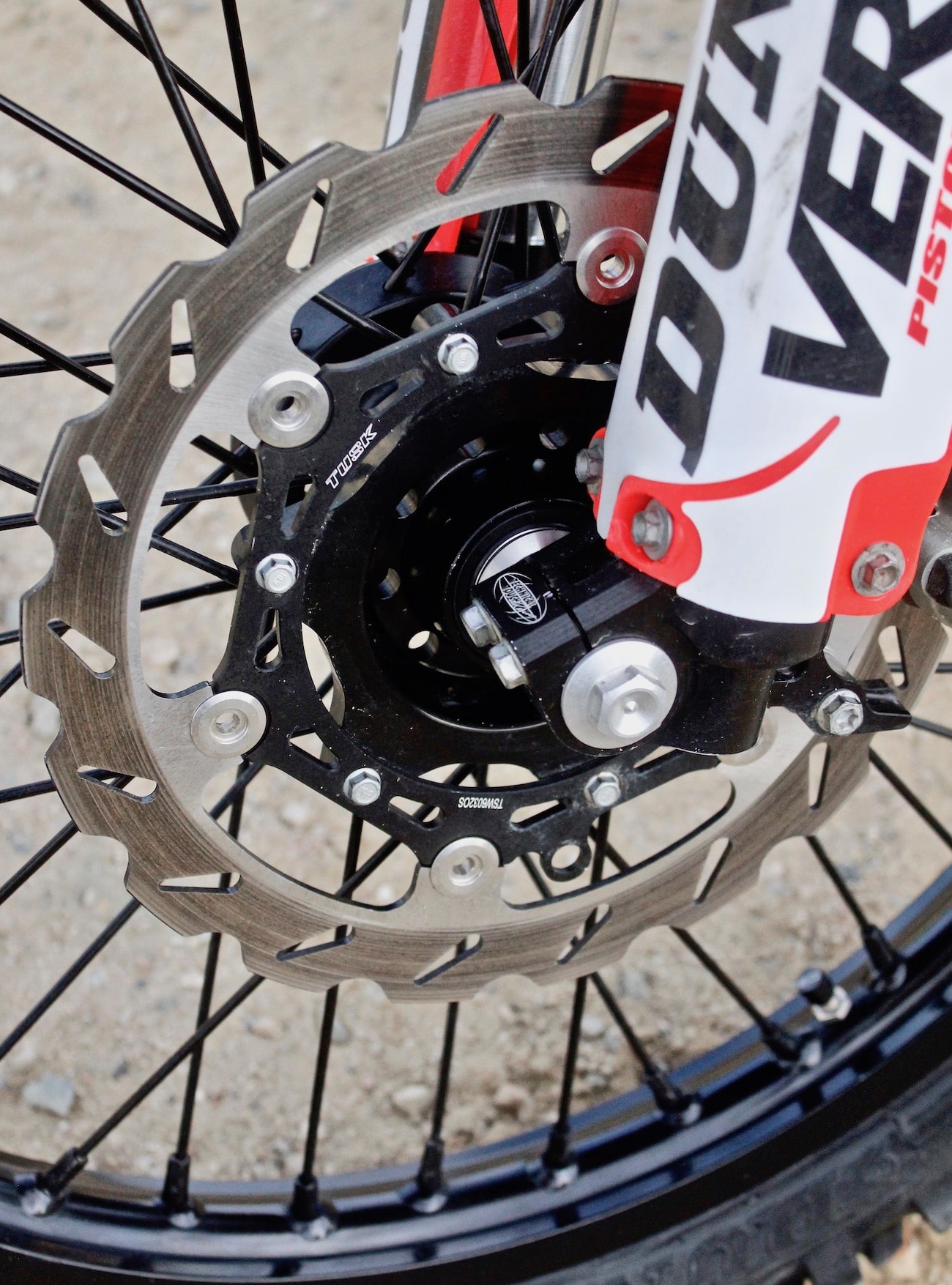
TUSK OFF ROAD: Tusk supplied the oversized rotor/adapter bracket for the Kayaba lugs, plus the rear rotor and sprocket bolts. www.tuskoffroad.com
TWISTED DEVELOPMENT: Cylinder head porting, mapping and engine setup. www.td-racing.com
UFO PLASTIC: The red KTM plastic came from UFO, along with the mud flap and frame guards. www.ufoplasticusa.com
VORTEX ECU IGNITION: To get the most out of our engine management system, we had Twisted Development add a Vortex ignition. www.td-racing.com
VP FUEL: We ran VP Racing T4 fuel, which is a high-quality replacement for pump gas. www.vpracingfuels.com
WORKS CONNECTION: All the bling (engraved brake caps, rotating front brake mount, engine plugs), bike stand and axle blocks were from Works Connection www.worksconnection.com


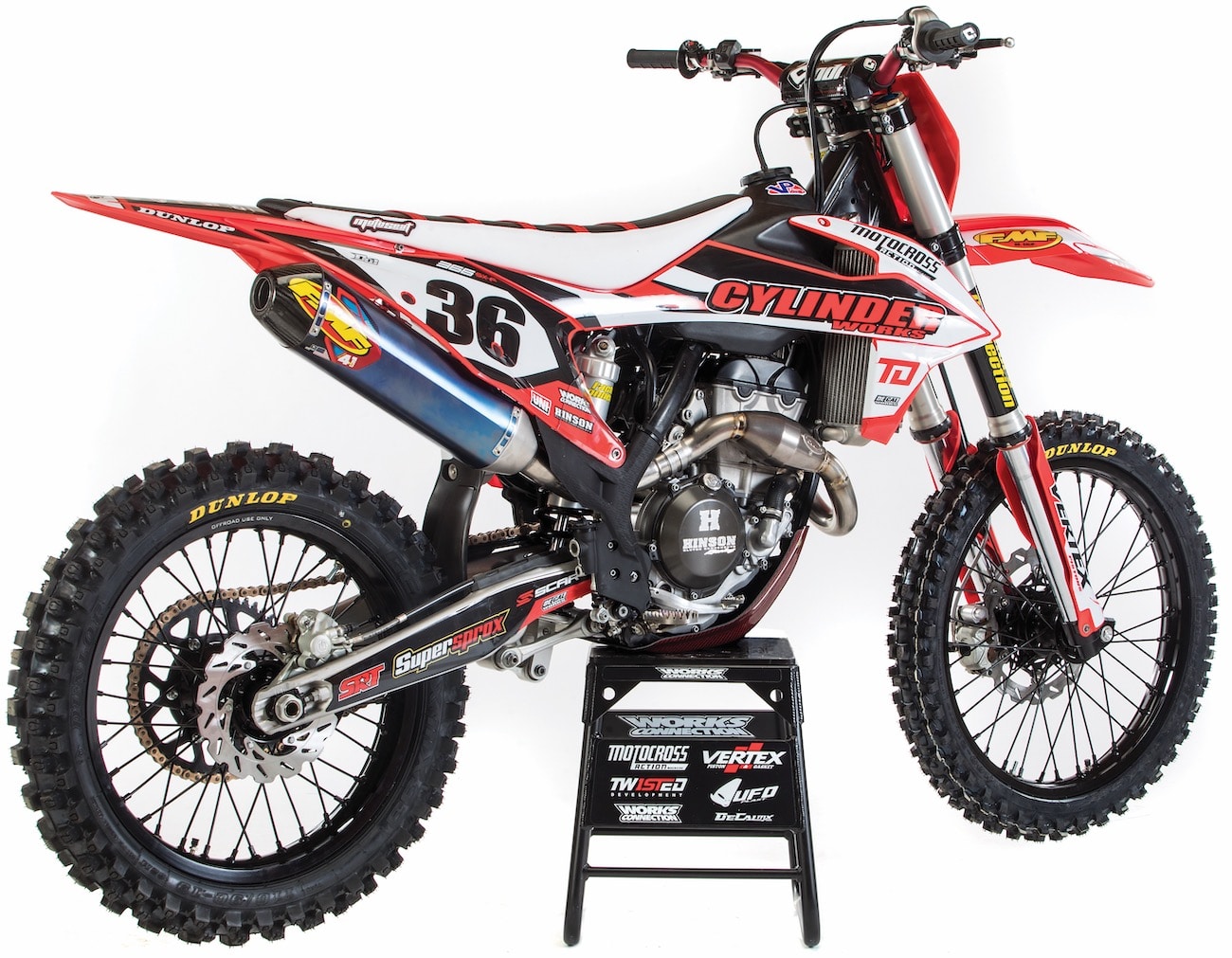
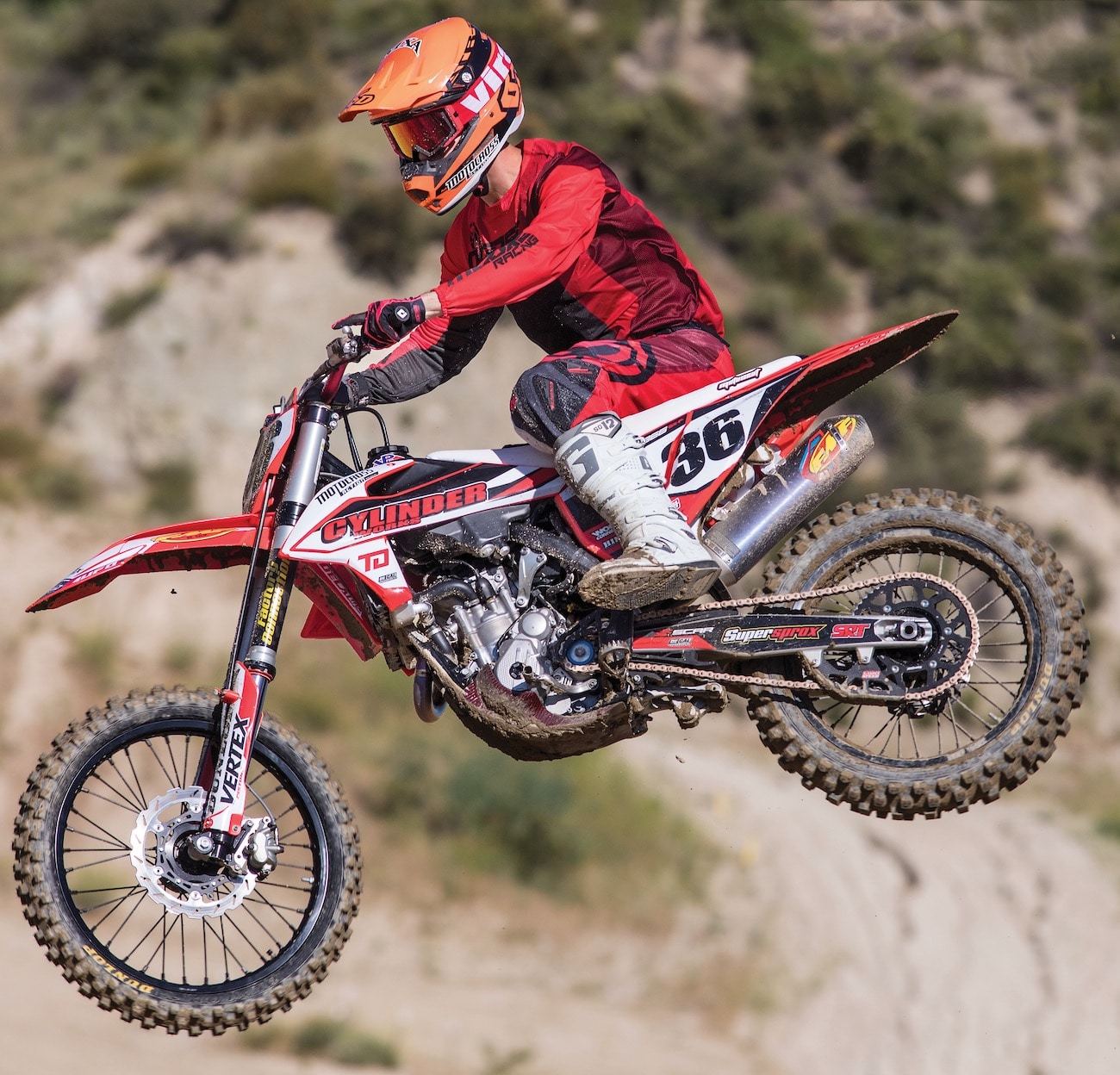

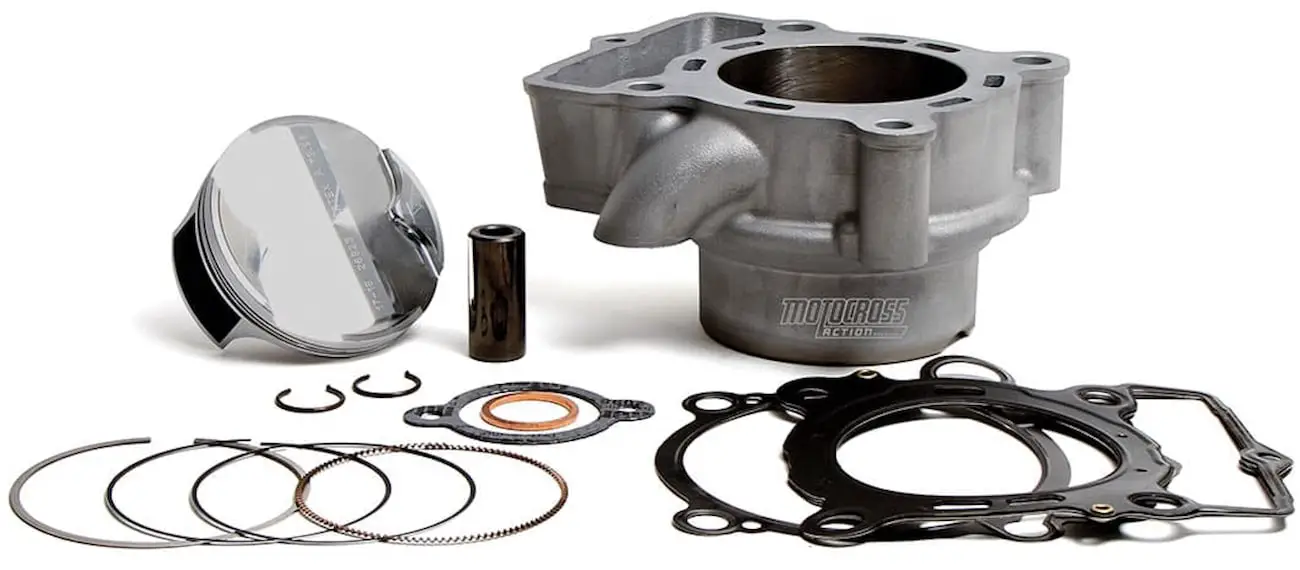
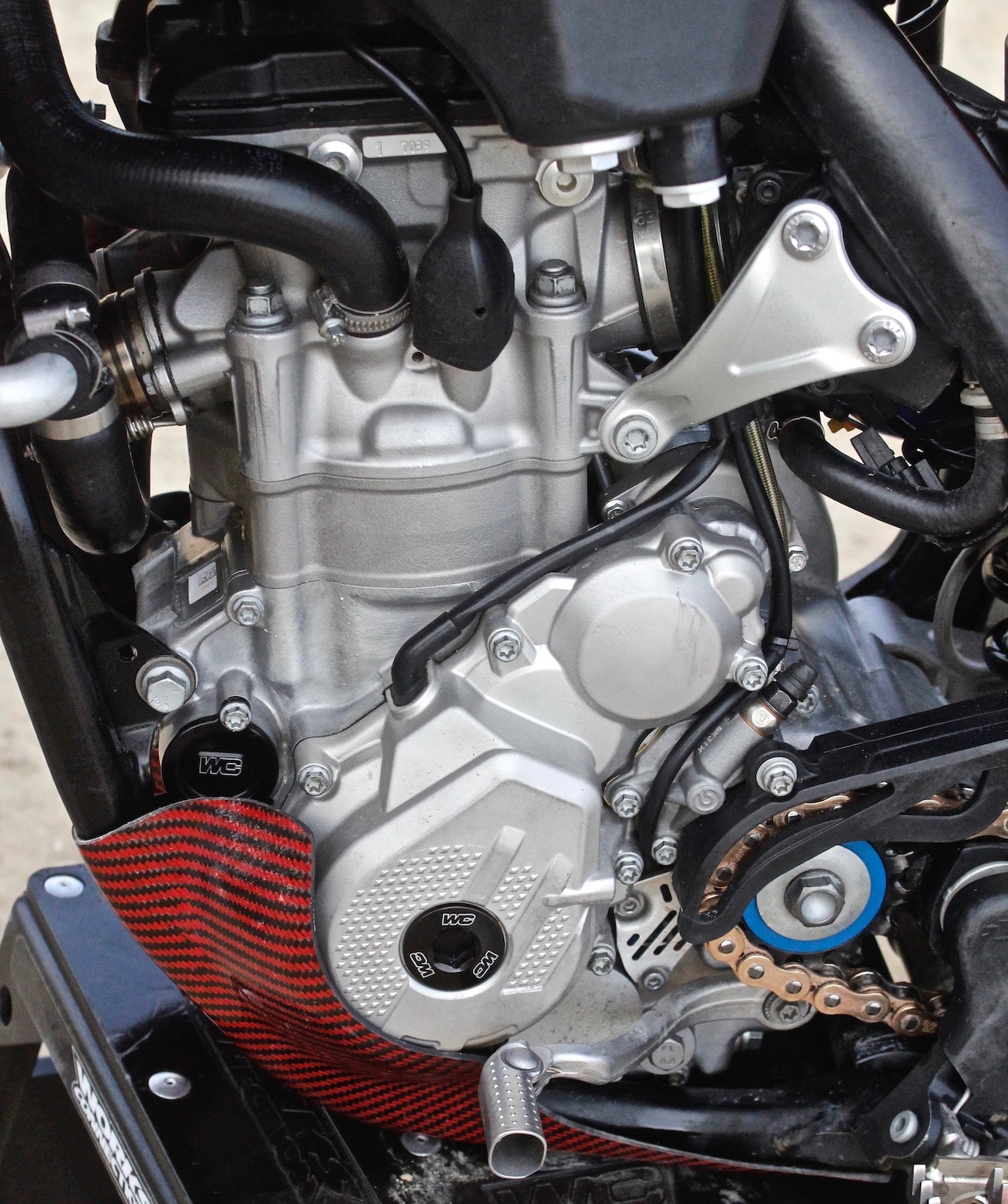
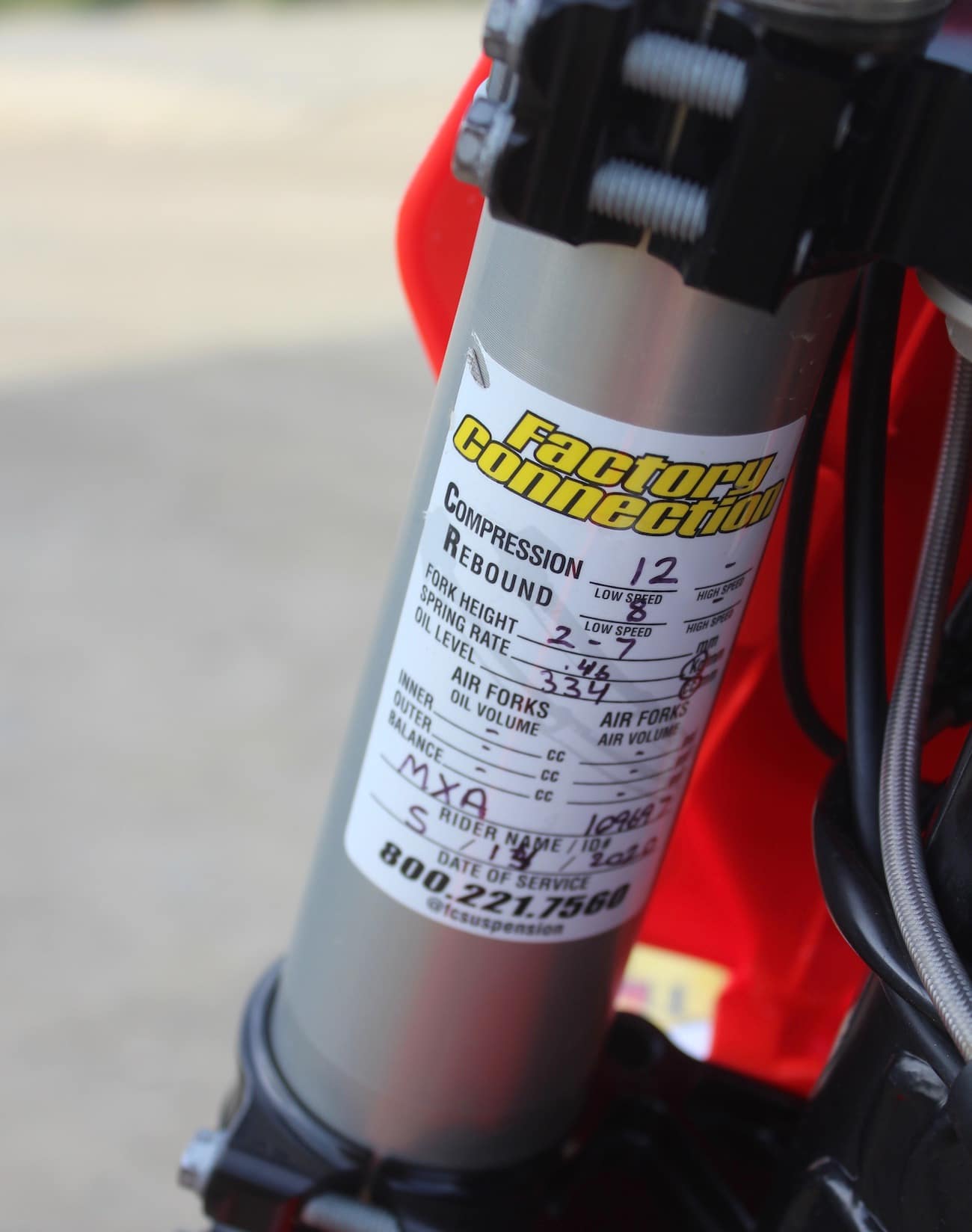
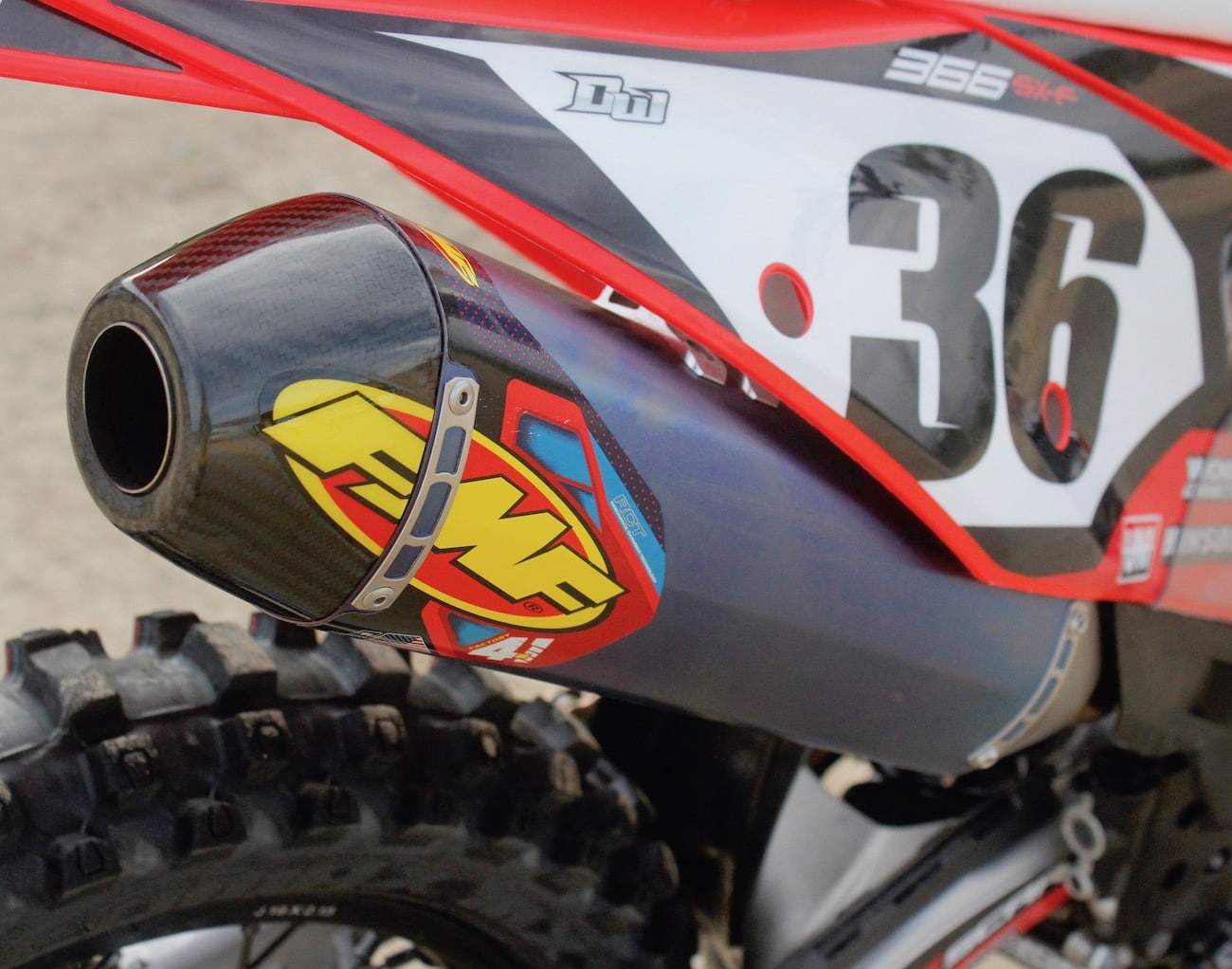




Comments are closed.